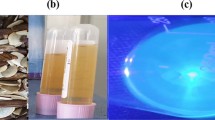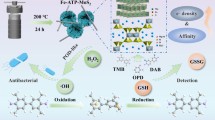Abstract
The pigment compound 2,5-di-tert-butyl-1,4-benzoquinone (DTBBQ) was selectively immobilized on multi-walled carbon nanotube (MWNT) during the electrochemical oxidation process. The glassy carbon electrode (GCE)/Q/MWNT showed a stable redox peak at 50 mV vs. Ag/AgCl in pH 7. Antibacterial activity of DTBBQ immobilized on multi-walled nanotube (hybrid DTBBQ/MWNT) against Bacillus cereus (MTCC 1168) and Escherichia coli (MTCC 2401) showed an enhanced minimum inhibitory concentration at 0.78 and 1.5 µg/mL against the bacterial pathogens. The results evidently show the immobilization of DTBBQ on CNT with enhanced redox response peaks observed at –0.01 V (Epa) and –0.2V (Epc) vs. Ag/AgCl. This new electrochemical method to immobilize the drugs onto MWNT is successfully demonstrated and would have potential applications as a remedy for removal of harmful microbes from the environment.



Similar content being viewed by others
REFERENCES
Bard, A.J. and Falukner, L.R., Electrochemical Methods: Fundamentals and Applications, Wiley, 2006, p. 580.
Barry, R.C., Lin, Y., Wang, J., Liu G., and Timchalk, C.A., Nanotechnology-based electrochemical sensors for biomonitoring chemical exposures electrochemical sensors for biomonitoring, J. Expo. Sci. Environ. Epid., 2009, vol. 19, p. 1.
Umasankar, Y. and Chen, S.M., A review on the electrochemical sensors and biosensors composed of nanowires as sensing material, Sensors, 2008, vol. 8, p. 290.
Zen, J.M., Kumar, A.S., and Tsai, D.M., Recent updates of chemically modified electrodes in analytical chemistry, Electroanalysis, 2003, vol. 15, p. 1073.
Zen, J.M., Senthil Kumar, A., and Tsai, D.M., Recent updates of chemically modified electrodes in analytical chemistry, Electroanalysis, 2003, vol. 15, p. 1073.
Avouris, P., Molecular electronics with carbon nanotubes, Acc. Chem. Res., 2002, vol. 35, no. 12, p. 1026.
Schroeder, V., Savagatrup, S., He, M., Lin, S., and Swager, T.M., Carbon nanotube chemical sensors, Chem. Rev., 2019, vol. 119, no. 1, p. 599.
Lee, W. and Parpura, V., Wiring neurons with carbon nanotubes, Front. Neuroengg., 2009, vol. 2, p. 1.
Chen, J., Chen, S., Zhao, X., Kuznetsova, L.V., Wong, S.S., and Ojima, I., Functionalized single walled carbon nanotubes as rationally designed vehicles for tumor-targeted drug delivery, J. Am. Chem. Soc., 2008, vol. 130, p. 16778.
Zhang, X., Meng, L., Lu, Q., Fei, Z., and Dyson, P.J., Targeted delivery and controlled release of doxorubicin to cancer cells using modified single wall carbon nanotubes, Biomaterials, 2009, vol. 30, p. 6041.
Pashow, K.M.L., Rocca, J.D., Huxford, R.C., and Lin, W., Hybrid nanomaterials for biomedical applications. Chem. Commun., 2010, vol. 46, p. 5832.
Yanagi, K., Miyata, Y., and Kataura, H., Highly stabilized β-carotene in carbon nanotubes, Adv. Mater., 2006, vol. 18, p. 437.
Smith, B.W., Monthioux, M., and Luzzi, D.E., Encapsulated C60 in carbon nanotubes, Nature, 1998, vol. 396, p. 323.
Holder, I.A. and Boyce, S.T., Agar well diffusion assay testing of bacterial susceptibility to various antimicrobials in concentrations non-toxic for human cells in culture, Burns, 1994, vol. 20, p. 426.
Senthil Kumar, A., Sornambikai, S., Deepika, L., and Zen, J.M., Highly selective immobilization of amoxicillin antibiotic on carbon nanotube modified electrodes and its antibacterial activity, J. Mater. Chem., 2010, vol. 20, p. 10152.
Assali, M., Zaid, A.N., Abdallah, F., Almasri, M., and Khayyat, R., Single-walled carbon nanotubes-ciprofloxacin nanoantibiotic: strategy to improve ciprofloxacin antibacterial activity, Int. J. Nanomed., 2017, vol. 12, p. 6647.
ACKNOWLEDGMENTS
The authors are grateful to the management of VIT University for providing the facilities to carry out this study.
Author information
Authors and Affiliations
Corresponding authors
Ethics declarations
The authors declare that they have no conflict of interest.
Rights and permissions
About this article
Cite this article
Jannu Vinay Gopal, Reddy, M.J. & Kannabiran, K. Immobilization of an Antibacterial Compound from Streptomyces sp. onto Multi-Walled Carbon Nanotubes. Russ J Electrochem 57, 92–96 (2021). https://doi.org/10.1134/S1023193521010043
Received:
Revised:
Accepted:
Published:
Issue Date:
DOI: https://doi.org/10.1134/S1023193521010043




